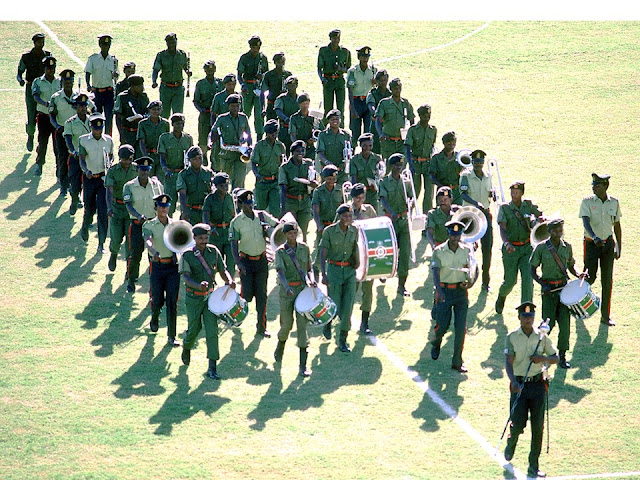Thursday, 1 May 1986: Wine Made from Oranges? Actually, not bad!
Nelspruit, eastern Transvaal
This morning, I’m riding on the “wrong” side of the road in a Toyota Cressida station wagon through the low veld countryside. Louise, from the South African Tourist Board (SATOUR), is driving. There are rolling tree-covered hills with colorful flowered trees here and there and scattered farm land. The climate in this area is sub-tropical. The sky is mostly overcast today; temperatures are in the low 70s; and it feels somewhat humid.
Before we head to Kruger National Park this afternoon, Louise is taking me to the only winery in northeastern South Africa. Don’t know if I can face alcohol this morning after a heavy bout with demon grape last night while typing up the story of my train ride here yesterday afternoon. But, I’ll try to be a good sport and not complain about the itinerary.
Our destination is the Rottcher Wineries. Louise tells me their wine is made from oranges. This is a citrus-growing area – no grapes in these parts.
Koot van den Heever takes me on a tour of the vintification process. They start out with orange juice in 1000-liter polypropylene tanks. Since the local oranges only have a 7% sugar content, they have to add sugar. Fermentation occurs when the yeast which they add reacts with the sugar. Koot emphasized that they do not add “spirits” (alcohol) to the wine. The fermentation is all natural. The concoction sits in the tubs or fiberglass vats for one to three months before they put it through a centrifuge which gets out all the particles and other impurities. I learn that the longer you let the wine ferment, the drier it becomes. So, their dry table wines take five or six years to be ready for consumption whereas the sweet sherry only takes a year. After centrifuging, the rest of this aging process takes place in 100 separate fiberglass vats in the adjoining room. Cork rots, so to avoid impurities from getting into the vats during the aging process, they use plastic stoppers with basket-like doohickeys on top.
Koot says they produce a different wine for blacks. Does apartheid even apply to taste buds in
South Africa? Actually, they have black
farm laborers taste the wine to find out what taste is most appealing. Local black taste favors a very dry,
carbonated wine which would be too bitter for the white palate.
Louise van Vuuren (SATOUR) & Karin Bloem (Rottcher Wineries) in the tasting room
They can produce up to 1250 bottles per day and do so about once every
two to four weeks. Lately, however,
they’ve been having labor problems. Even
on a wine tour, one can’t get away from political issues in this country! The winery employs 14 blacks and they have an
additional 40 at their macadamia nut farm.
None of the black workers are here today explains Karin Bloem who is
serving me samples of their various wines (dry, semi-dry, ginger, semi-sweet,
and sweet). Today is May Day and a
national work stay-away is being staged by blacks. There have been a number of stay-aways
lately. According to Karin, these
strikes are being enforced by gangs of youths who are not in school. While the black employees would like to come
to work, they are afraid. If the gangs
see them going to work, they may beat up their wives and children or burn down
their houses. They might also grab the
strike-breaker, throw a tire around his neck, douse it with petrol, and set him
on fire. Karin says they have asked
their “head boy” (foreman) why the men don’t stand up to the gangs, but it
would be difficult and life-threatening to do so.
With an average of one stay-away a week, the winery/nut farm can no longer afford to pay the workers when they miss work. Karin claims that the men are treated well by the company. Their transportation to work and medical needs are covered. She says they care for their workers like children. But because of all the stay-aways, they are looking at how to automate the work to reduce the need for laborers. Koot is planning a trip to Hawaii to see how nut farms are operated there. I have this feeling that everyone here, black and white, finds themselves in a “loose-loose” situation.
I purchase a bottle of Witrivier Dry 1980 for only R3.25! Good stuff, though I’ll still stick with dry grape wine for most of my imbibing.
There is a family of white South Africans from Cape Town on the tour. When the wife learns I am a writer she says,
“I hope you’re not going to write bad things about South Africa.” She explains that an American writer had
lived in a small town in the western Cape Province and wrote a nasty account
about the local people. She claimed he
misled them because they didn’t know he would be writing about them. She didn’t fool me on this one as I had read
the book (Waiting: The Whites of South Africa by Vincent
Crapanzano, a New York anthropologist).
I found the book to be a balanced account. As for misleading people, the South African
government knew he was there to do a study.
I do think that white South Africans are paranoid when people write
about them. Maybe they have something to
hide.




Comments
Post a Comment